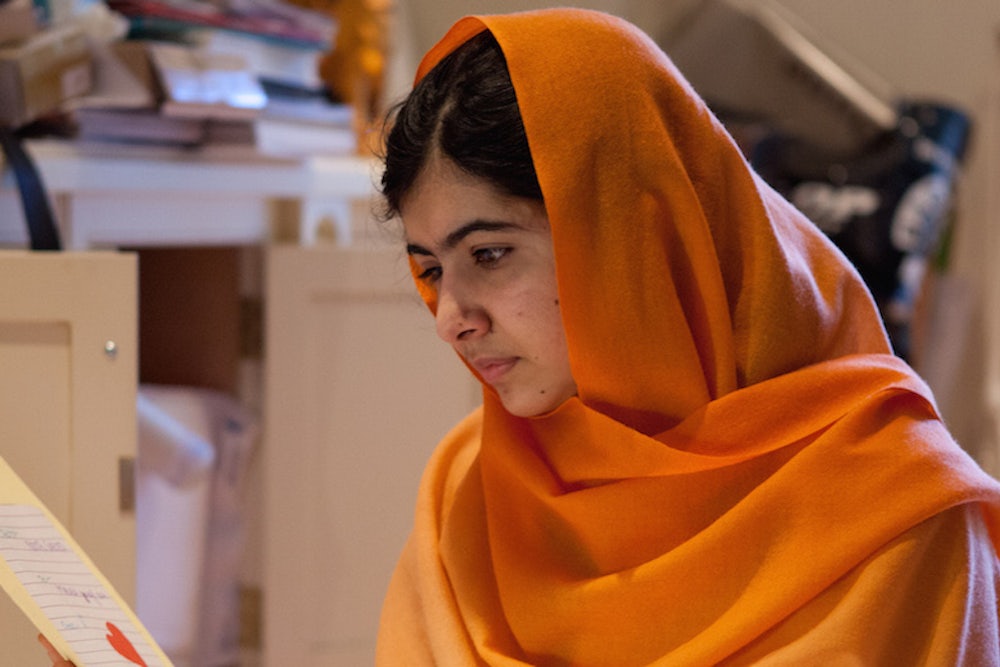In the late nineteenth-century, as the British attempted to add Afghanistan to their vast empire, a teenage girl armed only with her voice rallied her people to a famous victory against the imperial invaders. Or so the story goes. As the warriors of her tribe fled the battlefield in defeat during the Second Anglo-Afghan War, she climbed to the top of a mountain and proclaimed, “It is better to live like a lion for one day than as a slave for one hundred years.” Hearing her cry, the soldiers turned around and drove the British back, but the girl was killed in the process.
Her name was Malala.
The legendary story of Malala of Maiwand, for whom Nobel Laureate Malala Yousafzai is named, opens He Named Me Malala, a new documentary about the teenage girl who stood up to the Taliban. It chronicles her years under Taliban rule in northwestern Pakistan, her life today in England, and how she came to live halfway across the world—and win a Nobel Peace Prize. After speaking out in support of women’s education and blogging about life under the regime for the BBC, Malala was shot in the head by a Taliban fighter in 2012. She survived the attack, though the left side of her face remains paralyzed.
This first segment is brought to life in a soft, painterly animation that provides historical context for Malala and seeks to mythologize her along the lines of her predecessor. With such an opening, He Named Me Malala promises an innovative look into the life of a teenager who won the 2014 Nobel Peace Prize and whose face graces a thousand book covers and news segments. But the use of animation throughout the film to fill in the gaps of Malala’s story is sadly the most interesting thing about this toothless, PR-driven documentary.
It may seem strange that a documentary featuring the Taliban would have little to say about conflict, but He Named Me Malala suffers from a lack of dramatic tension throughout. It sticks to Malala’s message, showing her various speeches calling for women’s education, her visit to Nigerian villages in the aftermath of Boko Haram’s kidnapping of schoolgirls in 2014, and other press events. Much of the time it feels like a feature-length advertisement, so much so that I was surprised there was no hotline to call to donate to her cause when the lights went up.
The one source of dramatic tension, sadly left unexplored, is that of the relationship between Malala and her father, Ziauddin Yousafzai, the “He” in the film’s title. An outspoken teacher in Pakistan, Ziauddin has clearly been a dominant figure in his daughter’s life, and he freely admits that he named his daughter after a legendary martyr in hopes that she would achieve a similar status. Critics, shown briefly in the movie, have accused Malala of being only a mouthpiece, a media-friendly puppet acting under the orders of her calculating, power-hungry father. Ziauddin himself claims that he did nothing more than give his daughter freedom, encouraging her to pursue her education. Malala also weighs in on the issue, but the documentary, which heavily features Ziauddin, leaves the question open. Whether it was fate or not, we’re left with a slight distaste for a man who has acted mostly through his daughter.
Other promising lines of inquiry also go unexamined: Just who is Malala Yousafzai? What is it like to be a teenage Nobel Laureate, the object of media frenzy normally reserved for A-list celebrities? What is it like to be the most famous refugee in the West, adjusting to the customs of a new life in England? The documentary hints at these tensions: Malala jets off to far-flung countries to advocate for girls’ education—at the cost of falling behind on her own homework; she feels awkward and out of place in her English high school; she Googles attractive tennis players—Federer is a favorite—but giggles and refuses to answer when asked whether she would ever ask a boy out. These moments, as well as shots of Malala at home with her brothers, tease at the bigger questions but ultimately shy away from them, making He Named Me Malala a wasted opportunity.
